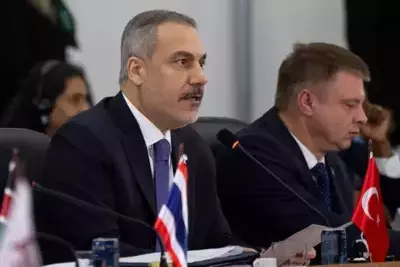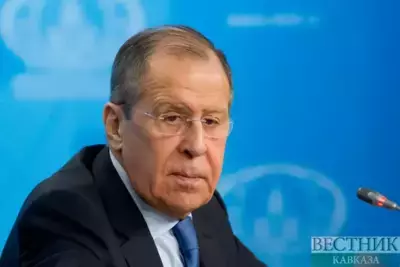The start of a new century and the arrival of a new administration in Washington in early 2001 led to a different set of priorities in U.S. policy toward the South Caucasus. The September 11 terrorist attacks and the wars in Afghanistan and Iraq altered Washington’s foreign policy priorities. The South Caucasus’s energy potential was undoubtedly still a factor in U.S. policy, in particular as an alternative to Russian energy in Europe. However, Washington’s focus shifted away from the unfinished business of the post-Soviet transitions and instead toward the needs of the new era. These included the logistics of conducting the war in the Afghan theater, the establishment of a global counterterrorism coalition, and the creation of an international coalition for the war in Iraq. It is stated in a survey by Carnegie Endowment for International Peace titled U.S. Policy Toward the South Caucasus: Take Three Vestnik Kavkaza presents the most interesting parts of the analysis. See Part 1 and Part 2
All three countries in the South Caucasus contributed troops to the U.S.-led coalitions in Iraq and Afghanistan. Georgia has been by far the most active contributor of troops to both operations, and its forces continue to serve in Afghanistan. Azerbaijan became an important logistics hub supporting U.S. troops in Afghanistan. However, as important as these undertakings were to the three countries’ relations with the United States, the countries themselves became second-tier priorities on the U.S. foreign policy agenda. The same was true of efforts to halt the fighting in Nagorno-Karabakh or Abkhazia, assist the newly independent states’ post-Soviet transitions, and build the Caspian infrastructure corridor.
U.S. policy in the South Caucasus was reenergized and refocused following Georgia’s 2003 Rose Revolution, which resulted in the overthrow of Shevardnadze, whose government was respected for its democratic credentials but discredited by widespread allegations of corruption and poor governance. In Shevardnadze’s place, the people of Georgia elected a young, charismatic new president, Mikheil Saakashvili—a U.S.-educated lawyer with strong democratic and reformist credentials—supported by a team of like-minded young leaders.
The new team in Tbilisi was equally determined to take the initiative in foreign and security policy. Instead of Shevardnadze’s cautious and ultimately unproductive approach to the separatist conflicts in Abkhazia and South Ossetia, the new government acted boldly in 2004 by seizing power in Adjara. Its longtime ruler, Aslan Abashidze, fled into exile in Russia. The message to Abkhazia and South Ossetia that they would be next was unmistakable.
But the new Georgian leadership had much bigger ambitions. It had set its sight on integration with the West and made its intention known in both Brussels and Washington. Brussels reacted cautiously to this message, based on Georgia’s difficult transition and the slow progress many Eastern and Central European countries were making toward integration with the West. But in Washington the reaction could not have been more enthusiastic. Democracy promotion was at the top of U.S. foreign policy agenda during the presidency of George W. Bush. Georgia was the outlier in the region and could potentially serve as a pioneer to reverse this pattern of stagnating reforms. Georgia’s aspirations were to follow the well-trodden path taken by Poland, Romania, and the Baltic states—which joined both NATO and the EU in 2004. Determined to leave Russia’s orbit, Georgia pursued its reforms—with a view toward first joining NATO and then, at a later date, the EU. As a result, Georgia became Washington’s favorite post-Soviet state, and the contrast between it and its neighbors was increasingly striking. In Ukraine, the Orange Revolution of 2004 brought to power a promising team of reformers. But their record in power proved disappointing to both the people of Ukraine and its supporters abroad, as the government got bogged down in personal rivalries, accusations of corruption, and competing political agendas.
As for Central Asia, where democratic changes had been slow to take hold, there was even less ground for optimism. U.S. relations with Uzbekistan were frozen in the wake of government suppression of an uprising in Andijan, which drew charges of excessive force from U.S. policymakers. In Kyrgyzstan, the so-called Tulip Revolution of 2005 resulted in the overthrow of a long-serving president reputed to be mired in corruption.

Askar Akayev
However, he was replaced by another reportedly equally corrupt and increasingly unpopular president, who in turn was overthrown five years later. From Washington’s perspective, then, Georgia was arguably the only post-Soviet state moving in the right direction. It was not only the undisputed reform leader in the South Caucasus and throughout the entire post-Soviet space, but also had explicitly adopted the goal of joining both NATO and the EU. It was a favorite of Washington and a thorn in Russia’s side. As a result, Georgia became a major irritant in U.S.-Russia bilateral relations and the two countries’ respective policies throughout the former Soviet Union. For Washington, Georgia became the champion of Euro-Atlantic integration and then president George W. Bush’s Freedom Agenda. For Moscow, Georgia’s integration into Western political and security structures had to be halted, as did Washington’s ambitions to expand NATO further to the east. At the 2007 Munich Security Conference, Putin bluntly warned the alliance against expanding closer to Russia’s borders and taking in new members. With Georgia as the lead candidate for membership among the post-Soviet states, the target of Putin’s message was hard to miss.
The clash of Euro-Atlantic expansion and Russian resistance culminated in August 2008. Speaking shortly afterward, then Russian president Dmitry Medvedev laid claim to a “sphere of privileged interests” for Russia around its periphery with the underlying message that this sphere would be off-limits to NATO and the EU.
The 2008 war between Russia and Georgia marked another turning point in the evolution of U.S. policy, not only toward Georgia but also toward the South Caucasus. The Kremlin’s military action made clear that it would not tolerate the expanded influence of the United States and its allies on its doorstep. The United States and its allies were not prepared to go to war with Russia over the issue of NATO expansion into the former Soviet states. As a result, Georgia found itself in limbo. It remained committed to its goal of NATO membership and closer ties to the EU, and it received assurances that its candidacy for NATO membership was alive. But its prospects for admission remained effectively nil as far as the eye could see. U.S. policy toward the South Caucasus had effectively lost its focus and its regional champion. That proved to be a Russian redline that Washington would not cross.
An Interlude — Europe in the Lead
The loss of momentum in the U.S.-Georgian relationship paved the way for a shift in policy leadership in the South Caucasus from the United States and NATO to the EU. The latter’s principal vehicle for engagement in the region became Association Agreements (AA), which did not hold out the possibility of membership explicitly but promised closer economic and political ties with the EU in exchange for economic and political reforms by aspiring states. Armenia and Georgia each pursued an AA actively, while Azerbaijan’s interest was lukewarm at best.
U.S. policy toward the South Caucasus following the Russo-Georgian war can be best described as managing the status quo rather than seeking breakthroughs or launching new initiatives. The most important U.S. diplomatic initiative to attempt a breakthrough on normalizing relations between Armenia and Turkey did not succeed. Afterwards, U.S. policy focused on efforts to prevent a new conflict between Russia and Georgia, avoid a breakdown in the anemic negotiating process between Armenia and Azerbaijan, help Georgia manage its potentially difficult political transition to the post-Saakashvili era, maintain working relations with the increasingly authoritarian and insecure regime in Azerbaijan, and preserve access to the region as a gateway to the Afghan war theater.

The next major shift in U.S. policy toward the South Caucasus was triggered by events in Ukraine in 2014. Armenia had to cancel its plan to sign its already negotiated AA with the EU and instead joined the Russian-led Eurasian Economic Union (EAEU). Given Yerevan’s close security ties to Russia, the decision to back away from the AA under Russian pressure did not lead to protests in Armenia as it did in Ukraine, although the government’s about-face was not uniformly popular. Georgia, however, defied Russian pressure and signed the AA with the EU in 2014.
The Ukraine crisis marked a major milestone in European security trends. It signaled the end of the post–Cold War era, when Europe, Russia, and the United States had all embraced the goal of common security without divisions or spheres of influence. The policy of the United States and its allies toward Russia could no longer follow a cooperative track absent a major shift in one side or the other’s fundamental approach to foreign policy and national security. The old U.S. policy framework is no longer applicable, but a new policy has not yet been put in place.
The South Caucasus After Crimea
Changes in that strategic environment are not limited to renewed Cold War–style East-West tensions. Within the South Caucasus, the break in relations between Russia and the West has triggered a split among the region’s three states. These three countries are pursuing three very different foreign policies at a time of major geopolitical changes around the region. Georgia is firmly on the path of Euro-Atlantic integration, seeking to distance itself from Russia as much as possible. Armenia is pursuing a course designed to maintain ties in both camps—Russia and the West. And Azerbaijan wants to keep both Russia and the West at arm’s length.
Georgia is determined to continue pursuing its rapprochement with the West and integration in both NATO and the EU. Its relations with Russia have not recovered from the war of 2008 and are unlikely to recover for the foreseeable future.
For Armenia, the key task is to balance its ties to both sides of the new East-West divide. Armenia, bound to Russia as a result of its geopolitical environment and security requirements, can ill-afford to risk undermining that critical relationship by getting too close to NATO and the EU. Armenia also has extensive ties to Europe and the United States, which are very important to its economy, society, and international standing. This explains why Armenia resumed negotiations with the EU in order to come up with an alternative to the AA it did not sign.
The Azerbaijani leadership showed little interest in and eventually refused to sign an AA with the EU similar to those signed by Georgia and almost signed by Armenia, instead demanding a special, higher-level agreement, and seeking to leverage its agreement with the EU to put pressure on Armenia in the Nagorno-Karabakh conflict. The EU and Azerbaijan have agreed to launch negotiations about a new comprehensive agreement, but the completion of these proceedings is uncertain. Meanwhile, the new comprehensive agreement between the EU and Armenia is being finalized. At the same time, Baku has not joined the Russian-led EAEU.
Russia, meanwhile, is intent on pursuing a harder line than before the Ukraine crisis, claiming an exclusive geopolitical sphere of influence around its periphery and aggressively promoting its EAEU as the counterweight to EU integration. At the same time, the South Caucasus’s longtime partners in the West are preoccupied with other, urgent matters. The EU is coping with multiple challenges—including the refugee crisis, relations with Russia and Moscow’s interference in several European elections, negotiations with the United Kingdom over Brexit, Ukraine’s struggle to sustain its reform momentum, and Greece’s seemingly never-ending troubles. This hardly leaves much time for EU policymakers to devote to the South Caucasus where one-size approaches do not fit all and where diversified diplomacy is necessary.
The United States, meanwhile, is focused on fighting the self-proclaimed Islamic State in Iraq and Syria, alongside other global and regional challenges, like the challenge of a rising China and the threat emanating from North Korea. Washington’s uncertain relationship with Moscow, which has become a major issue in U.S. domestic politics, leaves unanswered many questions about U.S. policy toward Russia’s neighbors, including the South Caucasus.

Other countries in the South Caucasus’s neighborhood also bear mentioning, particularly China, Iran, and Turkey. Turkey is undergoing its own transition to an increasingly authoritarian political system, culminating in the approval of an April 2017 referendum that expands the country’s presidential powers. The outcome of the referendum was a major victory for President Recep Tayyip Erdoğan—who is widely seen as intent on establishing an authoritarian state in Turkey—and a blow to the country’s democratic institutions. Turkey’s relations with both Europe and the United States have suffered as a result, and Ankara is unlikely to play the role of the West’s partner in the South Caucasus as was previously expected. Erdoğan’s rapprochement with Putin raises questions about Turkish policy in the South Caucasus and deals Ankara may be prepared to conclude with Moscow at the expense of its South Caucasus neighbors.
The South Caucasus could benefit from the growing regional presence of Iran, which is gradually shedding the burden of its international isolation as a result of the P5+1 nuclear deal. This is likely to be more important for Armenia than for Azerbaijan and Georgia. In the event of another conflict with Azerbaijan, Iran could be an especially valuable outlet and trade partner for Yerevan, since Armenia’s border with Turkey remains closed, leaving it entirely dependent on Georgia for access to the outside world. At the same time, Armenia, Azerbaijan, and Georgia all may benefit from China’s growing penetration of the South Caucasus and in particular its ambitious Belt and Road Initiative, which includes future infrastructure development projects that traverse the region. However, both Iran and China have close relations with Russia, and neither is likely to act in the foreseeable future as a geopolitical counterweight to Moscow.
Despite the multitude of changes in and around the South Caucasus region, the principal challenge for its three states remains their relationship with Russia and the task of balancing it with their ties to the West. Russia has a number of advantages in dealing with the region—geographic proximity, demonstrated willingness to use force, and a claim, backed up by its actions, that it cares more about and has more at stake in the region than the United States and its European allies and partners do.
















